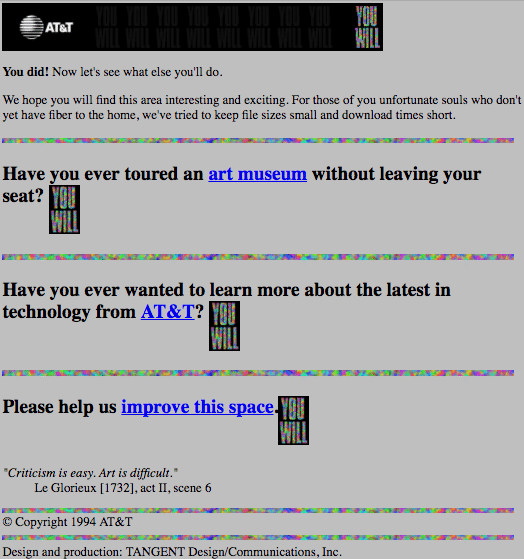The First-Ever Banner Ad on the Web
People don’t often click on banner ads these days—at least not on purpose, anyway. In fact, many internet users actively go out of their way to never see advertisements.
Ad blockers create all kinds of problems for companies that rely on ad dollars to pay their workers (cough cough like journalists cough), but it’s understandable why ad blockers appeal to people. Display ads are too often clunky, ugly, and intrusive—all kinds of ad trackers collect and sell data about people.
All this is part of why reports that Google will make ad blocking part of its Chrome web browser are so ominous: Google, the largest beneficiary of web advertising on the planet, wants to block ads that help anybody else make money.
How did we get here?
There was a time, in another century, when people used to click on banner ads. Back when they were still a novelty some 20 years ago, people even shared links to banner ads—or, at least, to the first one ever, anyway. The banner ad that’s widely described as the first ever was a little rectangle purchased by AT&T on HotWired.com in 1994. About 44 percent of the people who saw it actually clicked on it.

The ad set off a chain reaction that altered the course of the advertising industry—and any other industry that overlapped with it. (“It’s almost like a prank that was played by the technology industry on the media industry 20 years ago,” Chris Dixon, the tech investor, told The New York Times in 2014.)
Recommended: Torching the Modern-Day Library of Alexandria
The first banner ad was part of AT&T’s larger “You Will” campaign, which included a series of television commercials featuring predicted scenes from an internet-enabled future—in many cases quite accurately. (One failure: AT&T predicted video calling, but not mobile video calling, imaging FaceTime taking place in a phone booth.)
According to Wired, HotWired had 14 additional banner ads ready to go from other companies—including Club Med, 1-800-Collect, and Zima—but AT&T just happened to be the first.
Banner ads caught on quickly. In 1995, Yahoo announced an advertising deal for their own primitive banner ads—with the logos of five sponsor companies rotating daily atop Yahoo’s site. By the time the Internet Archive’s Wayback Machine captured the first glimpse of HotWired, in 1997, there were multiple advertisements on the site, including display ads for discount PCs and data centers. The real problem for HotWired’s ad agency at the time, Ryan Singel wrote for Wired in 2010, “was realizing that banner ads would be clickable, so it had to create websites for its clients, who weren’t even sure that interacting online was a good idea—or that the ads were even legal.”
Recommended: How Online Shopping Makes Suckers of Us All
When people clicked AT&T’s 1994 banner ad, they wound up at a simple landing page that offered more information about AT&T. The answer to “Have you ever clicked your mouse right here?” became, on the new page, “You did! Now let’s see what else you’ll do.”

Ads dramatically changed the early web, including the way companies operated and how websites themselves looked. You can see this evolution clearly, thanks to the web designer Jeffrey Veen’s catalogue of how HotWired.com changed in appearance from 1994 to 1999, when it was owned by Lycos and leveraged for monetized clicks. HotWired split off from the print magazine, Wired, when Condé Nast bought Wired for $80 million in 1998. That transaction took place after years of speculation that Wired might go public.
Recommended: Trump Realizes Being President Is Hard
Well before that, by 1996, people were already complaining about cyberspace’s new billboards as “boring and ineffective,” according to The New York Times that year. Today’s display ads fare even worse, with a clickthrough rate of about .05 percent, according to the marketing research firm SmartInsights.
“Banner ads didn’t always suck,” Joe McCambley, who helped design the AT&T ad in 1994, wrote for Harvard Business Review. “My children tell me that’s like inventing smallpox.”
The person who created the first pop-up ad is similarly sheepish about what he wrought. “I’m sorry,” Ethan Zuckerman, who coded the first pop-up ad, wrote for The Atlantic in 2014. “Our intentions were good.”
Advertisers liked pop ups, he once told me, because they created a distinction between the advertisement and whatever was on the webpage where the ad appeared. The funny thing is, as display advertising falls away, that distinction is collapsing in other ways. Increasingly, brands want to be perceived as storytellers and publishers in their own right.
Eventually, consumers will find a way to block that out, too.
Read more from The Atlantic:
This article was originally published on The Atlantic.
